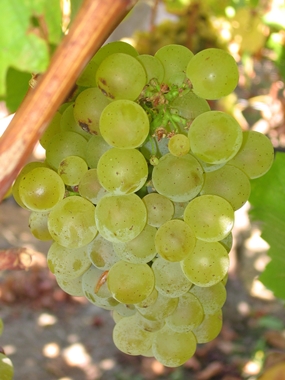During a conversation a few days ago, someone was wondering about the meaning of a “varietal” wine. Just in case you are a bit hazy about it, let me explain. So sit up and listen carefully. A varietal describes a wine made primarily from a single grape variety, rather than a blend of several grapes. The name of the grape nearly always dominates the label.
If you see a wine labelled Cabernet Sauvignon, Chardonnay or Merlot, it’s a varietal. Wines that show the names of two or more grape varieties on their label, such as Semillon-Sauvignon, are blends and not varietal wines.
 Sauvignon grapes on the vine
Sauvignon grapes on the vine
In ideal conditions, a varietal is made from 100% of the grape shown on the label but in practice, winemakers sometimes need to enhance the wine with the addition of juice from another grape variety. In most wine-producing countries, the regulations allow that a varietal wine must contain at least 85% of the grape shown on the label.
I mention all this because both wines this week are varietals. Sauvignon Blanc (SOH-vee-nyon BLAHN) is not usually a refined and elegant wine. The name comes from the French word sauvage (“wild”) and French Sauvignons often have the aromas of straw, grass, smoke, green herbs and flint. Delicate they are not. The more audacious ones are sometimes described as having the character of cat’s pee. This, you might be surprised to know, is considered a positive attribute. Unless you happen to be a connoisseur of cat’s pee, you’ll be pleased to hear that there’s no hint of it in this Chilean one.
Terra Sur Sauvignon Blanc 2011 (white), Chile (Friendship, Bt. 389)
Terra Sur means “Land of the South” and the Sauvignons from Chilean tend to be lighter, fruitier and less acidic than their cousins from France. This one is a pale gold wine, with a splendid rich aroma of gooseberries, citrus fruits, spring-like grassiness and hints of fresh herbs. It’s a lovely light, dry wine with an attractive prickly sensation on the palate and there’s also a dash of citrus and a pleasing bite of very mild acidity. On the taste, the gooseberries are out in force and the citrusy finish seems to go on and on. This is a very well-crafted and refreshing young wine. At just 12.5% alcohol content it’s a lively easy-drinker that would make a terrific apéritif.
Terra Sur Merlot 2010 (white), Chile (Friendship, Bt. 389)
This is a very dark red, almost crimson colour. There’s an intriguing brambly and earthy aroma of spicy fruit, blackcurrants and dark plums. You might even pick up faint hints of minty chocolate way in the background. The aroma kept me occupied for several minutes, because it was so interesting. And I hope you always get your nose to work before you start drinking. It’s amazing the number of people who just don’t bother. This always strikes me as a terrible waste.
Anyway, after a good nosing, you’ll find that the wine is very dry and quite full-bodied with an attractive velvety mouth-feel and satisfying tannins. It’s packed with damsons and plums and there’s a pleasing touch of woodiness with a long tangy finish. There’s rather an attractive edge to the taste too, which gives the wine a touch of assertiveness despite its soft mouth-feel.
This really is a splendid wine. Like many reds, it will probably show at its best with food. It would make an excellent partner for most red meat dishes or rich vegetarian food and would almost certainly work well with pasta too.
Merlot incidentally, was once considered a second-best to Cabernet Sauvignon and in Bordeaux, it’s usually used as a blending wine to soften up the Cabernet. One of the notable exceptions is the legendary Château Pétrus which makes equally legendary wines, almost completely from the Merlot grape. The latest Château Pétrus has just been released and is being hailed as the best vintage for 100 years. If you feel like splashing out, you can pick up a bottle of the 2005 Pétrus for around Bt. 200,000 – and that’s only the starting price. If big numbers make your head go fuzzy, that’s about $6,500 or £4,000. Just bear in mind that you’ll have to wait at least ten years before it’ll be ready to drink.




